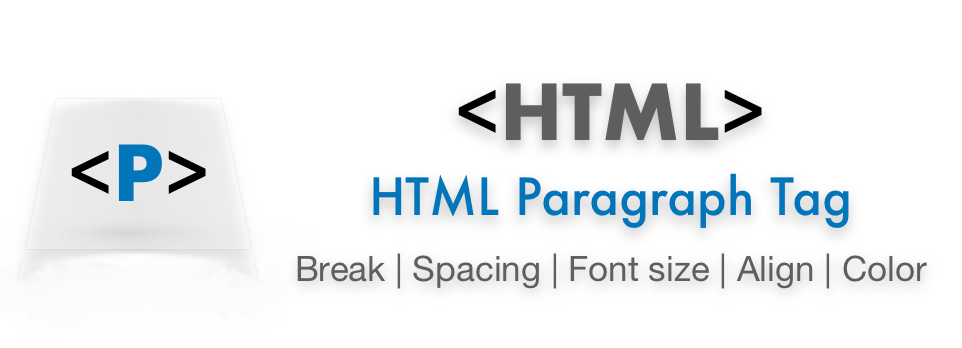HTML Tutorial
- HTML HOME
- HTML Introduction
- HTML Editors
- HTML Basics
- HTML Comments
- HTML Elements
- HTML Attributes
- HTML Headings
- HTML Paragraphs
- HTML Styles
- HTML Text Formatting
- HTML Quotations
- HTML Colors
- HTML Links
- HTML Images
- HTML Favicons: How to Add and Optimize for All Browsers
- HTML Page Title: How to Optimize Titles for SEO Success
- HTML Tables: Create & Optimize for Better Web Design | Codeezy
- HTML Lists: Types, Examples & SEO Tips for Better Structure
- HTML Block and Inline Elements
- HTML Iframes
- HTML File Paths
- HTML Layout
- HTML Computer Code Elements
- HTML Semantics
- HTML5 Semantics
- HTML Entities
- HTML Symbols
- HTML Emojis
- HTML Charsets
HTML Paragraphs: Structure, Syntax, and Enhancements

The `<p>` tag in HTML defines a paragraph, which is a fundamental block of text within web pages. It encapsulates content between opening `<p>` and closing `</p>` tags, allowing browsers to recognize and format the text as a distinct paragraph. Being a block-level element, a new paragraph always starts on a fresh line, and browsers automatically add space before and after it, enhancing readability.
Syntax
<p> Content goes here </p>
Key Properties of the <p> Tag
Space Compression:
- HTML reduces multiple consecutive spaces within a paragraph to a single space.
- Likewise, multiple line breaks or newlines added by the user are collapsed into a single space by default.
Block-Level Display:
- The
<p>tag inherently behaves as a block-level element, meaning it occupies the full width available and starts on a new line. This default behavior can be customized using CSS for more advanced layouts.
- The
Practical Examples of the <p> Tag
Example 1: Basic usage of the <p> tag.
<!DOCTYPE html>
<html lang="en">
<head>
<meta charset="UTF-8">
<meta name="viewport" content="width=device-width, initial-scale=1.0">
<title>The `<p>` Tag</title>
</head>
<body>
<p>Welcome to the world of HTML!</p>
<p>HTML allows you to structure your content effectively.</p>
</body>
</html>
Output:
- The above example demonstrates two paragraphs, each on its line, with the default spacing applied by the browser.
Example 2: Handling multiple lines within a paragraph.
<!DOCTYPE html>
<html lang="en">
<head>
<meta charset="UTF-8">
<meta name="viewport" content="width=device-width, initial-scale=1.0">
<title>Multiple Lines in a Paragraph</title>
</head>
<body>
<p>
This is a paragraph with multiple lines.
HTML reduces these lines into a single line,
disregarding the line breaks added in the code.
</p>
</body>
</html>
Output:
- Despite the code containing multiple lines, the browser renders it as a single, continuous line.
Enhancing Paragraphs with <br> and <hr> Tags
The <br> Tag:
- The
<br>tag in HTML introduces a line break without starting a new paragraph. It’s useful when you want to break the line within a paragraph without breaking the logical flow of the content.
<p>
This is an example using the <br> tag.
The line breaks occur <br> without starting a new paragraph.
</p>
The <hr> Tag:
- The
<hr>tag creates a horizontal line, visually separating sections within a webpage. It’s often used to signify transitions or breaks between topics.
<!DOCTYPE html>
<html lang="en">
<head>
<meta charset="UTF-8">
<meta name="viewport" content="width=device-width, initial-scale=1.0">
<title>Horizontal Rule Example</title>
</head>
<body>
<h1>HTML Basics</h1>
<p>Understanding the basics of HTML is crucial for web development.</p>
<hr>
<p>Next, we will explore advanced topics in HTML.</p>
</body>
</html>
Customizing Paragraph Alignment with the <align> Attribute
Although the align attribute has been deprecated in HTML5, it was traditionally used to align text within a paragraph. Today, CSS is the preferred method for text alignment.
Example:
<!DOCTYPE html>
<html lang="en">
<head>
<meta charset="UTF-8">
<meta name="viewport" content="width=device-width, initial-scale=1.0">
<title>Paragraph Alignment</title>
</head>
<body>
<p style="text-align:center;">
Center-aligned text using CSS.
</p>
<p style="text-align:left;">
Left-aligned text using CSS.
</p>
<p style="text-align:right;">
Right-aligned text using CSS.
</p>
</body>
</html>
Using the <pre> Tag for Preformatted Text
The <pre> tag is used for displaying preformatted text. It preserves both spaces and line breaks, making it ideal for displaying code snippets or any content where precise formatting is necessary.
Example:
<!DOCTYPE html>
<html lang="en">
<head>
<meta charset="UTF-8">
<meta name="viewport" content="width=device-width, initial-scale=1.0">
<title>Preformatted Text Example</title>
</head>
<body>
<pre>
This is preformatted text.
It preserves all spaces
and line breaks as entered.
</pre>
</body>
</html>
Output:
- Unlike the standard
<p>tag, the<pre>tag retains the original formatting, displaying text exactly as it appears in the HTML code.
Supported Browsers
HTML paragraphs are universally supported across all modern browsers, including:
FAQs
1. What is the <p> tag in HTML?
- The
<p>tag defines a paragraph, grouping related sentences and text into a cohesive block.
2. Can paragraphs contain other HTML elements?
- Yes, paragraphs can include other inline elements like
<a>,<strong>,<em>, and<span>.
3. How do you create a line break within a paragraph?
- Use the
<br>tag to insert a line break without starting a new paragraph.
4. What is the <pre> tag used for?
- The
<pre>tag is used for displaying preformatted text, retaining spaces and line breaks as they appear in the code.
Thank You for Visiting Codeezy.org!
We’re thrilled to have you as part of our coding community. Your engagement and support inspire us to continue providing high-quality resources and tools to enhance your web development journey. Whether you’re a beginner or an experienced coder, we hope you found valuable insights and tools here at Codeezy.
Stay connected for more tips, tutorials, and updates to help you code with ease. Thank you for choosing Codeezy.org—your growth as a developer is our motivation!
Happy coding!
